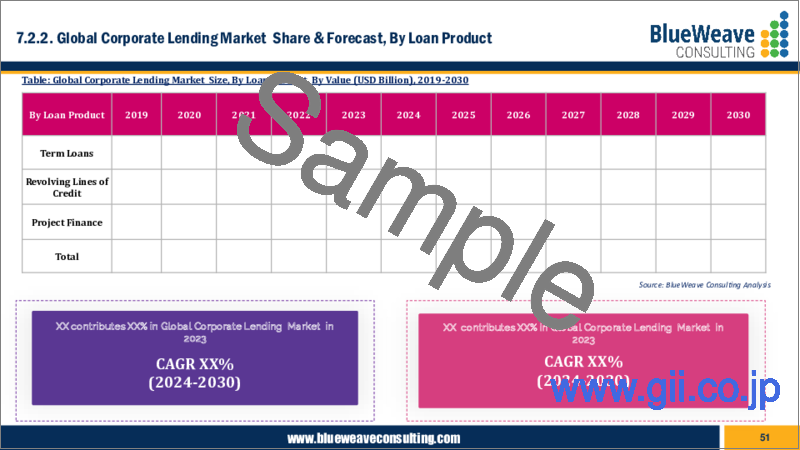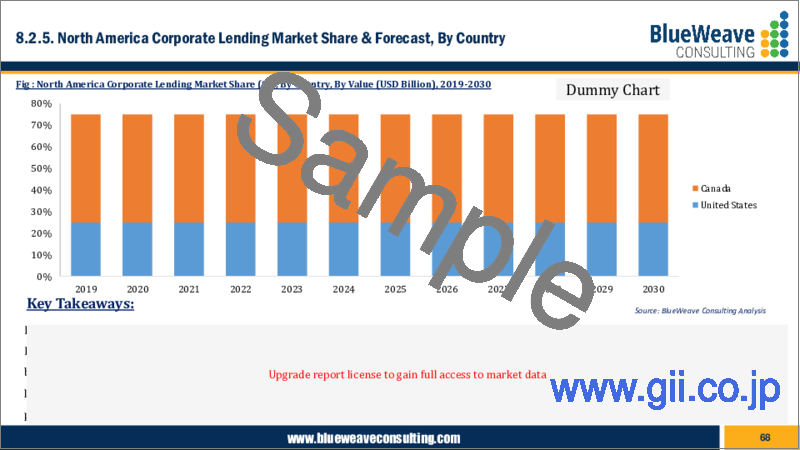|
|
市場調査レポート
商品コード
1500676
法人向け融資市場- 世界の規模、シェア、動向分析、機会、予測レポート、2019-2030年Corporate Lending Market - Global Size, Share, Trend Analysis, Opportunity and Forecast Report, 2019-2030, Segmented By Borrower Type; By Loan Product; By Lender Type; By Loan Purpose; By Region |
||||||
|
|||||||
| 法人向け融資市場- 世界の規模、シェア、動向分析、機会、予測レポート、2019-2030年 |
|
出版日: 2024年05月23日
発行: Blueweave Consulting
ページ情報: 英文 400 Pages
納期: 2~3営業日
|
全表示
- 概要
- 目次
世界の法人向け融資市場規模がCAGR 10.65%で倍増以上、2030年には7兆8,800億米ドルに達する
世界の法人向け融資市場は、経済成長、企業の拡大、金利の上昇、厳しい規制政策、技術進歩の急速な導入、世界の融資動向と慣行を形成する激しい市場競争により、急速に拡大しています。
戦略コンサルティングと市場調査の大手企業であるブルーウィーブ・コンサルティング(BlueWeave Consulting)は最近の調査で、2023年の世界の企業向け融資市場規模を金額ベースで3兆8,100億米ドルと推定しました。2024年から2030年までの予測期間中、BlueWeaveは世界の法人向け融資市場規模がCAGR 10.65%で拡大し、2030年には7兆8,800億米ドルに達すると予測しています。世界の法人向け融資市場は、経済状況、金利、規制政策、技術進歩など、いくつかの要因によって左右されます。経済成長と安定性は借入ニーズに影響し、金利は企業の借入コストに影響します。自己資本比率要件などの規制政策は、融資慣行やリスク管理戦略を形成します。また、デジタル・プラットフォームやブロックチェーンのような技術的進歩は、融資プロセスを変革し、効率を高め、市場範囲を拡大しています。
機会- 代替融資イノベーション
今日のダイナミックな金融情勢において、オルタナティブ融資は世界・法人向け融資市場の極めて重要な成長要因として浮上しています。伝統的な銀行業務の制約や借り手のニーズの進化に伴い、オルタナティブ融資・プラットフォームは革新的なソリューションを提供し、企業にとってのアクセシビリティと柔軟性を促進しています。ピアツーピア(P2P)融資、クラウドファンディング、フィンテック・ソリューションのようなテクノロジー主導のアプローチを通じて、企業は従来の手段を超えたオーダーメイドの資金調達オプションを見つけることができます。市場の多様化は融資機会を拡大するだけでなく、市場競争を促進し、効率性と費用対効果を高める。企業がオルタナティブ・チャネルをますます受け入れるようになるにつれ、世界の法人向け融資市場は力強い拡大を遂げ、金融の包括性と機敏性の新時代が到来します。
地政学的緊張の高まりが世界の法人向け融資市場に与える影響
地政学的緊張の高まりは、世界の法人向け融資市場に大きな影響を与えます。不確実性の高まりは貸し手にリスクの再評価を促し、貸し出し条件を引き締める可能性があります。例えば、米国と中国の貿易戦争では、景気減速やサプライチェーンの混乱への懸念から、貸し手の警戒感が強まった。さらに、特定の国に対する制裁措置は、その地域で活動する企業の信用へのアクセスを制限する可能性があります。地政学的な不安定さは金利にも影響を与え、世界中の企業の借入コストに影響を与えます。さらに、地政学的な出来事は通貨変動の引き金となり、融資の決定をさらに複雑にします。緊張が高まった場合、貸し手はより保守的なアプローチをとる可能性があり、貸出活動の減少や投資意欲の減退につながり、世界の法人向け融資市場全体の成長やダイナミクスに影響を与えます。
世界の法人向け融資市場
セグメント別カバレッジ
世界の法人向け融資市場-ローン商品別
ローン商品に基づき、世界の法人向け融資市場はタームローン、リボルビング・クレジット・ライン、プロジェクト・ファイナンスの各セグメントに分けられます。プロジェクト・ファイナンス・セグメントは、大規模なベンチャー企業の資金調達に不可欠な役割を果たすため、最大のローン商品となっています。プロジェクト・ファイナンスは、エネルギー、交通、建設などの大規模なインフラ・プロジェクトへの投資を促進します。その意義は、各プロジェクト特有のニーズとリスクに合わせた長期資金を提供することにあり、世界中の投資家から多額の資金を集めています。このセグメントの複雑さと範囲の広さは、企業向け融資の要であり、様々な業界の成長とイノベーションを促進しています。
世界の法人向け融資市場-レンダー・タイプ別
レンダーのタイプ別に見ると、世界の法人向け融資市場は商業銀行、シャドーバンク、オルタナティブレンダーの各セグメントに分けられます。商業銀行セグメントは通常、世界の企業向け貸出市場で最大の貸出先タイプです。商業銀行は広範なネットワークを持つ定評ある金融機関であり、企業に幅広い融資サービスを提供しています。商業銀行は、その安定性、利用しやすさ、企業のニーズに合わせた多様な金融商品により、しばしば企業に好まれています。その膨大なリソース、規制監督、金融業界における長年の評判は、企業向け融資市場における彼らの傑出した存在感を高めており、資金調達ソリューションを求める多くの企業にとって主要な選択肢となっています。
競合情勢
世界の法人向け融資市場の競争は激しいです。同市場の主要企業には、JJPMorgan Chase & Co., Bank of America Corporation, Citigroup Inc., Goldman Sachs Group Inc., Morgan Stanley, UBS Group AG, Credit Suisse Group AG, Julius Baer Group Ltd, Bank of China Limited, and HSBC Holdings plc、中国銀行、HSBCホールディングスなどがあります。これらの企業は、研究開発活動への投資拡大、合併・買収、合弁事業、提携、ライセンス契約、新製品・新サービスのリリースなど、さまざまな戦略を駆使して、世界の法人向け融資市場における地位をさらに強化しています。
当レポートの詳細な分析により、世界の企業向け貸出市場の成長可能性、今後の動向、統計に関する情報を提供します。また、総市場規模の予測を促進する要因も取り上げています。当レポートは、世界の企業向け貸出市場における最近の技術動向や、意思決定者が健全な戦略的意思決定を行うための業界洞察を提供することをお約束します。さらに、市場の成長促進要因・課題・競争力学についても分析しています。
目次
第1章 調査の枠組み
第2章 エグゼクティブサマリー
第3章 世界企業融資市場の洞察
- 業界バリューチェーン分析
- DROC分析
- 成長促進要因
- 企業からの資本需要の増加
- 新興市場の成長
- 融資プラットフォームのデジタル化
- 低金利
- 抑制要因
- 経済の不確実性
- 金利上昇
- 規制の監視強化
- 機会
- 代替融資
- データ駆動型融資
- グリーン融資
- 課題
- 競合
- サイバーセキュリティの脅威
- 信用リスク管理
- 成長促進要因
- 技術の進歩/最近の動向
- 規制の枠組み
- ポーターのファイブフォース分析
第4章 世界企業融資市場:マーケティング戦略
第5章 世界の企業向け融資市場:価格分析
第6章 世界の企業融資市場:地域分析
- 世界の企業融資市場、地域分析、2023年
- 世界の企業融資市場の魅力分析、2024-2030年
第7章 世界の企業融資市場概要
- 市場規模と予測、2019-2030年
- 金額別
- 市場シェアと予測
- 借り手タイプ別
- 大企業
- 中小企業
- ローン商品別
- タームローン
- 回転信用枠
- プロジェクトファイナンス
- 貸し手タイプ別
- 商業銀行
- 影の銀行
- 代替融資業者
- ローン目的別
- 運転資本
- 拡大
- 債務借り換え
- 国別
- 北米
- 欧州
- アジア太平洋
- ラテンアメリカ
- 中東およびアフリカ
- 借り手タイプ別
第8章 北米の法人融資市場
- 市場規模と予測、2019-2030年
- 金額別
- 市場シェアと予測
- 借り手タイプ別
- ローン商品別
- 貸し手タイプ別
- ローン目的別
- 国別
- 米国
- カナダ
第9章 欧州の企業融資市場
- 市場規模と予測、2019-2030年
- 金額別
- 市場シェアと予測
- 借り手タイプ別
- ローン商品別
- 貸し手タイプ別
- ローン目的別
- 国別
- ドイツ
- 英国
- イタリア
- フランス
- スペイン
- ベルギー
- ロシア
- オランダ
- その他欧州
第10章 アジア太平洋の企業融資市場
- 市場規模と予測、2019-2030年
- 金額別
- 市場シェアと予測
- 借り手タイプ別
- ローン商品別
- 貸し手タイプ別
- ローン目的別
- 国別
- 中国
- インド
- 日本
- 韓国
- オーストラリアとニュージーランド
- インドネシア
- マレーシア
- シンガポール
- ベトナム
- アジア太平洋のその他諸国
第11章 ラテンアメリカの企業融資市場
- 市場規模と予測、2019-2030年
- 金額別
- 市場シェアと予測
- 借り手タイプ別
- ローン商品別
- 貸し手タイプ別
- ローン目的別
- 国別
- ブラジル
- メキシコ
- アルゼンチン
- ペルー
- その他のラテンアメリカ
第12章 中東・アフリカの法人融資市場
- 市場規模と予測、2019-2030年
- 金額別
- 市場シェアと予測
- 借り手タイプ別
- ローン商品別
- 貸し手タイプ別
- ローン目的別
- 国別
- サウジアラビア
- アラブ首長国連邦
- カタール
- クウェート
- 南アフリカ
- ナイジェリア
- アルジェリア
- 中東・アフリカのその他
第13章 競合情勢
- 主要企業とそのドライブタイプのリスト
- 2023年の世界企業融資企業の市場シェア分析
- 経営パラメータによる競合ベンチマーキング
- 主要な戦略的展開(合併、買収、提携など)
第14章 世界企業融資市場:輸入と輸出
第15章 地政学的緊張の高まりが世界の企業融資市場に与える影響
第16章 企業プロファイル(会社概要、財務マトリックス、競合情勢、主要人物、主要競合、連絡先、戦略展望、 SWOT分析)
- JPMorgan Chase &Co.
- Bank of America Corporation
- Citigroup Inc.
- Goldman Sachs Group Inc.
- Morgan Stanley
- UBS Group AG
- Credit Suisse Group AG
- Julius Baer Group Ltd
- Bank of China Limited
- HSBC Holdings plc
- その他の主要企業
第17章 主要な戦略的提言
第18章 調査手法
Global Corporate Lending Market Size More Than Doubles at Robust CAGR of 10.65% to Touch Whopping USD 7.88 Trillion by 2030
Global Corporate Lending Market is expanding rapidly due to economic growth, corporate expansion, increasing interest rates, stringent regulatory policies, rapid adoption of technological advancements, and intense market competition shaping lending trends and practices worldwide.
BlueWeave Consulting, a leading strategic consulting and market research firm, in its recent study, estimated the Global Corporate Lending Market size by value at USD 3.81 trillion in 2023. During the forecast period between 2024 and 2030, BlueWeave expects the Global Corporate Lending Market size to expand at a CAGR of 10.65% reaching a value of USD 7.88 trillion by 2030. The Global Corporate Lending Market is driven by several factors including economic conditions, interest rates, regulatory policies, and technological advancements. Economic growth and stability influence borrowing needs, while interest rates affect the cost of borrowing for corporations. Regulatory policies, such as capital adequacy requirements, shape lending practices, and risk management strategies. Also, technological advancements, like digital platforms and blockchain, are transforming lending processes, enhancing efficiency, and expanding market reach.
Opportunity - Alternative lending innovations
In today's dynamic financial landscape, alternative lending emerges as a pivotal growth driver for the Global Corporate Lending Market. With traditional banking constraints and evolving borrower needs, alternative lending platforms offer innovative solutions, fostering accessibility and flexibility for businesses. Through technology-driven approaches like peer-to-peer (P2P) lending, crowdfunding, and fintech solutions, corporations find tailored financing options beyond conventional avenues. Diversification expands lending opportunities but also enhances market competition, driving efficiency and cost-effectiveness. As businesses increasingly embrace alternative channels, the Global Corporate Lending Market experiences robust expansion, ushering in a new era of financial inclusivity and agility.
Impact of Escalating Geopolitical Tensions on Global Corporate Lending Market
Escalating geopolitical tensions has profound effects on the Global Corporate Lending Market. Heightened uncertainty prompts lenders to reassess risk, potentially tightening lending conditions. For instance, the United States-China trade war saw increased caution among lenders due to fears of economic slowdown and supply chain disruptions. Additionally, sanctions against certain countries can restrict access to credit for firms operating in those regions. Geopolitical instability also influences interest rates, impacting borrowing costs for corporations globally. Moreover, geopolitical events can trigger currency fluctuations, further complicating lending decisions. In times of heightened tension, lenders may adopt a more conservative approach, leading to decreased lending activity and reduced investment appetite, affecting the overall growth and dynamics of the Global Corporate Lending Market.
Global Corporate Lending Market
Segmental Coverage
Global Corporate Lending Market - By Loan Product
Based on loan product, Global Corporate Lending Market is divided into Term Loans, Revolving Lines of Credit, and Project Finance segments. The project finance segment is the largest loan product due to its integral role in funding large-scale ventures. Project finance facilitates investment in extensive infrastructure projects, such as energy, transportation, and construction initiatives. Its significance lies in providing long-term funding tailored to the specific needs and risks of each project, attracting substantial capital from investors worldwide. The segment's complexity and scope make it a cornerstone of corporate lending, driving growth and innovation across various industries.
Global Corporate Lending Market - By Lender Type
Based on lender type, Global Corporate Lending Market is divided into Commercial Banks, Shadow Banks, and Alternative Lenders segments. The commercial banks segment typically represents the largest lender type in the Global Corporate Lending Market. They are established financial institutions with extensive networks, offering a wide range of lending services to corporations. Commercial banks are often preferred by businesses due to their stability, accessibility, and diverse financial products tailored to corporate needs. Their vast resources, regulatory oversight, and longstanding reputation in the financial industry contribute to their prominence in the corporate lending market, making them the primary choice for many businesses seeking financing solutions.
Competitive Landscape
Global Corporate Lending Market is fiercely competitive. Major companies in the market include JPMorgan Chase & Co., Bank of America Corporation, Citigroup Inc., Goldman Sachs Group Inc., Morgan Stanley, UBS Group AG, Credit Suisse Group AG, Julius Baer Group Ltd, Bank of China Limited, and HSBC Holdings plc. These companies use various strategies, including increasing investments in their R&D activities, mergers, and acquisitions, joint ventures, collaborations, licensing agreements, and new product and service releases to further strengthen their position in the Global Corporate Lending Market.
The in-depth analysis of the report provides information about growth potential, upcoming trends, and statistics of the Global Corporate Lending Market. It also highlights the factors driving forecasts of total Market size. The report promises to provide recent technology trends in Global Corporate Lending Market and industry insights to help decision-makers make sound strategic decisions. Further, the report also analyzes the growth drivers, challenges, and competitive dynamics of the market.
Table of Contents
1. Research Framework
- 1.1. Research Objective
- 1.2. Product Overview
- 1.3. Market Segmentation
2. Executive Summary
3. Global Corporate Lending Market Insights
- 3.1. Industry Value Chain Analysis
- 3.2. DROC Analysis
- 3.2.1. Growth Drivers
- 3.2.1.1. Increasing demand for capital from businesses
- 3.2.1.2. Growth of emerging markets
- 3.2.1.3. Digitalization of lending platforms
- 3.2.1.4. Low interest rates
- 3.2.2. Restraints
- 3.2.2.1. Economic uncertainty
- 3.2.2.2. Rising interest rates
- 3.2.2.3. Increasing regulatory scrutiny
- 3.2.3. Opportunities
- 3.2.3.1. Alternative lending
- 3.2.3.2. Data-driven lending
- 3.2.3.3. Green lending
- 3.2.4. Challenges
- 3.2.4.1. Competition
- 3.2.4.2. Cybersecurity threats
- 3.2.4.3. Credit risk management
- 3.2.1. Growth Drivers
- 3.3. Technological Advancements/Recent Developments
- 3.4. Regulatory Framework
- 3.5. Porter's Five Forces Analysis
- 3.5.1. Bargaining Power of Suppliers
- 3.5.2. Bargaining Power of Buyers
- 3.5.3. Threat of New Entrants
- 3.5.4. Threat of Substitutes
- 3.5.5. Intensity of Rivalry
4. Global Corporate Lending Market: Marketing Strategies
5. Global Corporate Lending Market: Pricing Analysis
6. Global Corporate Lending Market: Geography Analysis
- 6.1. Global Corporate Lending Market, Geographical Analysis, 2023
- 6.2. Global Corporate Lending Market Attractiveness Analysis, 2024-2030
7. Global Corporate Lending Market Overview
- 7.1. Market Size & Forecast, 2019-2030
- 7.1.1. By Value (USD Billion)
- 7.2. Market Share & Forecast
- 7.2.1. By Borrower Type
- 7.2.1.1. Large Enterprises
- 7.2.1.2. Small and Medium-sized Enterprises (SMEs)
- 7.2.2. By Loan Product
- 7.2.2.1. Term Loans
- 7.2.2.2. Revolving Lines of Credit
- 7.2.2.3. Project Finance
- 7.2.3. By Lender Type
- 7.2.3.1. Commercial Banks
- 7.2.3.2. Shadow Banks
- 7.2.3.3. Alternative Lenders
- 7.2.4. By Loan Purpose
- 7.2.4.1. Working Capital
- 7.2.4.2. Expansion
- 7.2.4.3. Debt Refinancing
- 7.2.5. By Country
- 7.2.5.1. North America
- 7.2.5.2. Europe
- 7.2.5.3. Asia Pacific (APAC)
- 7.2.5.4. Latin America (LATAM)
- 7.2.5.5. Middle East and Africa (MEA)
- 7.2.1. By Borrower Type
8. North America Corporate Lending Market
- 8.1. Market Size & Forecast, 2019-2030
- 8.1.1. By Value (USD Billion)
- 8.2. Market Share & Forecast
- 8.2.1. By Borrower Type
- 8.2.2. By Loan Product
- 8.2.3. By Lender Type
- 8.2.4. By Loan Purpose
- 8.2.5. By Country
- 8.2.5.1. United States
- 8.2.5.1.1. By Borrower Type
- 8.2.5.1.2. By Loan Product
- 8.2.5.1.3. By Lender Type
- 8.2.5.1.4. By Loan Purpose
- 8.2.5.2. Canada
- 8.2.5.2.1. By Borrower Type
- 8.2.5.2.2. By Loan Product
- 8.2.5.2.3. By Lender Type
- 8.2.5.2.4. By Loan Purpose
9. Europe Corporate Lending Market
- 9.1. Market Size & Forecast, 2019-2030
- 9.1.1. By Value (USD Billion)
- 9.2. Market Share & Forecast
- 9.2.1. By Borrower Type
- 9.2.2. By Loan Product
- 9.2.3. By Lender Type
- 9.2.4. By Loan Purpose
- 9.2.5. By Country
- 9.2.5.1. Germany
- 9.2.5.1.1. By Borrower Type
- 9.2.5.1.2. By Loan Product
- 9.2.5.1.3. By Lender Type
- 9.2.5.1.4. By Loan Purpose
- 9.2.5.2. United Kingdom
- 9.2.5.2.1. By Borrower Type
- 9.2.5.2.2. By Loan Product
- 9.2.5.2.3. By Lender Type
- 9.2.5.2.4. By Loan Purpose
- 9.2.5.3. Italy
- 9.2.5.3.1. By Borrower Type
- 9.2.5.3.2. By Loan Product
- 9.2.5.3.3. By Lender Type
- 9.2.5.3.4. By Loan Purpose
- 9.2.5.4. France
- 9.2.5.4.1. By Borrower Type
- 9.2.5.4.2. By Loan Product
- 9.2.5.4.3. By Lender Type
- 9.2.5.4.4. By Loan Purpose
- 9.2.5.5. Spain
- 9.2.5.5.1. By Borrower Type
- 9.2.5.5.2. By Loan Product
- 9.2.5.5.3. By Lender Type
- 9.2.5.5.4. By Loan Purpose
- 9.2.5.6. Belgium
- 9.2.5.6.1. By Borrower Type
- 9.2.5.6.2. By Loan Product
- 9.2.5.6.3. By Lender Type
- 9.2.5.6.4. By Loan Purpose
- 9.2.5.7. Russia
- 9.2.5.7.1. By Borrower Type
- 9.2.5.7.2. By Loan Product
- 9.2.5.7.3. By Lender Type
- 9.2.5.7.4. By Loan Purpose
- 9.2.5.8. The Netherlands
- 9.2.5.8.1. By Borrower Type
- 9.2.5.8.2. By Loan Product
- 9.2.5.8.3. By Lender Type
- 9.2.5.8.4. By Loan Purpose
- 9.2.5.9. Rest of Europe
- 9.2.5.9.1. By Borrower Type
- 9.2.5.9.2. By Loan Product
- 9.2.5.9.3. By Lender Type
- 9.2.5.9.4. By Loan Purpose
10. Asia Pacific Corporate Lending Market
- 10.1. Market Size & Forecast, 2019-2030
- 10.1.1. By Value (USD Billion)
- 10.2. Market Share & Forecast
- 10.2.1. By Borrower Type
- 10.2.2. By Loan Product
- 10.2.3. By Lender Type
- 10.2.4. By Loan Purpose
- 10.2.5. By Country
- 10.2.5.1. China
- 10.2.5.1.1. By Borrower Type
- 10.2.5.1.2. By Loan Product
- 10.2.5.1.3. By Lender Type
- 10.2.5.1.4. By Loan Purpose
- 10.2.5.2. India
- 10.2.5.2.1. By Borrower Type
- 10.2.5.2.2. By Loan Product
- 10.2.5.2.3. By Lender Type
- 10.2.5.2.4. By Loan Purpose
- 10.2.5.3. Japan
- 10.2.5.3.1. By Borrower Type
- 10.2.5.3.2. By Loan Product
- 10.2.5.3.3. By Lender Type
- 10.2.5.3.4. By Loan Purpose
- 10.2.5.4. South Korea
- 10.2.5.4.1. By Borrower Type
- 10.2.5.4.2. By Loan Product
- 10.2.5.4.3. By Lender Type
- 10.2.5.4.4. By Loan Purpose
- 10.2.5.5. Australia & New Zealand
- 10.2.5.5.1. By Borrower Type
- 10.2.5.5.2. By Loan Product
- 10.2.5.5.3. By Lender Type
- 10.2.5.5.4. By Loan Purpose
- 10.2.5.6. Indonesia
- 10.2.5.6.1. By Borrower Type
- 10.2.5.6.2. By Loan Product
- 10.2.5.6.3. By Lender Type
- 10.2.5.6.4. By Loan Purpose
- 10.2.5.7. Malaysia
- 10.2.5.7.1. By Borrower Type
- 10.2.5.7.2. By Loan Product
- 10.2.5.7.3. By Lender Type
- 10.2.5.7.4. By Loan Purpose
- 10.2.5.8. Singapore
- 10.2.5.8.1. By Borrower Type
- 10.2.5.8.2. By Loan Product
- 10.2.5.8.3. By Lender Type
- 10.2.5.8.4. By Loan Purpose
- 10.2.5.9. Vietnam
- 10.2.5.9.1. By Borrower Type
- 10.2.5.9.2. By Loan Product
- 10.2.5.9.3. By Lender Type
- 10.2.5.9.4. By Loan Purpose
- 10.2.5.10. Rest of APAC
- 10.2.5.10.1. By Borrower Type
- 10.2.5.10.2. By Loan Product
- 10.2.5.10.3. By Lender Type
- 10.2.5.10.4. By Loan Purpose
11. Latin America Corporate Lending Market
- 11.1. Market Size & Forecast, 2019-2030
- 11.1.1. By Value (USD Billion)
- 11.2. Market Share & Forecast
- 11.2.1. By Borrower Type
- 11.2.2. By Loan Product
- 11.2.3. By Lender Type
- 11.2.4. By Loan Purpose
- 11.2.5. By Country
- 11.2.5.1. Brazil
- 11.2.5.1.1. By Borrower Type
- 11.2.5.1.2. By Loan Product
- 11.2.5.1.3. By Lender Type
- 11.2.5.1.4. By Loan Purpose
- 11.2.5.2. Mexico
- 11.2.5.2.1. By Borrower Type
- 11.2.5.2.2. By Loan Product
- 11.2.5.2.3. By Lender Type
- 11.2.5.2.4. By Loan Purpose
- 11.2.5.3. Argentina
- 11.2.5.3.1. By Borrower Type
- 11.2.5.3.2. By Loan Product
- 11.2.5.3.3. By Lender Type
- 11.2.5.3.4. By Loan Purpose
- 11.2.5.4. Peru
- 11.2.5.4.1. By Borrower Type
- 11.2.5.4.2. By Loan Product
- 11.2.5.4.3. By Lender Type
- 11.2.5.4.4. By Loan Purpose
- 11.2.5.5. Rest of LATAM
- 11.2.5.5.1. By Borrower Type
- 11.2.5.5.2. By Loan Product
- 11.2.5.5.3. By Lender Type
- 11.2.5.5.4. By Loan Purpose
12. Middle East & Africa Corporate Lending Market
- 12.1. Market Size & Forecast, 2019-2030
- 12.1.1. By Value (USD Billion)
- 12.2. Market Share & Forecast
- 12.2.1. By Borrower Type
- 12.2.2. By Loan Product
- 12.2.3. By Lender Type
- 12.2.4. By Loan Purpose
- 12.2.5. By Country
- 12.2.5.1. Saudi Arabia
- 12.2.5.1.1. By Borrower Type
- 12.2.5.1.2. By Loan Product
- 12.2.5.1.3. By Lender Type
- 12.2.5.1.4. By Loan Purpose
- 12.2.5.2. UAE
- 12.2.5.2.1. By Borrower Type
- 12.2.5.2.2. By Loan Product
- 12.2.5.2.3. By Lender Type
- 12.2.5.2.4. By Loan Purpose
- 12.2.5.3. Qatar
- 12.2.5.3.1. By Borrower Type
- 12.2.5.3.2. By Loan Product
- 12.2.5.3.3. By Lender Type
- 12.2.5.3.4. By Loan Purpose
- 12.2.5.4. Kuwait
- 12.2.5.4.1. By Borrower Type
- 12.2.5.4.2. By Loan Product
- 12.2.5.4.3. By Lender Type
- 12.2.5.4.4. By Loan Purpose
- 12.2.5.5. South Africa
- 12.2.5.5.1. By Borrower Type
- 12.2.5.5.2. By Loan Product
- 12.2.5.5.3. By Lender Type
- 12.2.5.5.4. By Loan Purpose
- 12.2.5.6. Nigeria
- 12.2.5.6.1. By Borrower Type
- 12.2.5.6.2. By Loan Product
- 12.2.5.6.3. By Lender Type
- 12.2.5.6.4. By Loan Purpose
- 12.2.5.7. Algeria
- 12.2.5.7.1. By Borrower Type
- 12.2.5.7.2. By Loan Product
- 12.2.5.7.3. By Lender Type
- 12.2.5.7.4. By Loan Purpose
- 12.2.5.8. Rest of MEA
- 12.2.5.8.1. By Borrower Type
- 12.2.5.8.2. By Loan Product
- 12.2.5.8.3. By Lender Type
- 12.2.5.8.4. By Loan Purpose
13. Competitive Landscape
- 13.1. List of Key Players and Their Drive Types
- 13.2. Global Corporate Lending Company Market Share Analysis, 2023
- 13.3. Competitive Benchmarking, By Operating Parameters
- 13.4. Key Strategic Developments (Mergers, Acquisitions, Partnerships, etc.)
14. Global Corporate Lending Market: Import & Export
15. Impact of Escalating Geopolitical Tensions on Global Corporate Lending Market
16. Company Profiles (Company Overview, Financial Matrix, Competitive Landscape, Key Personnel, Key Competitors, Contact Address, Strategic Outlook, and SWOT Analysis)
- 16.1. JPMorgan Chase & Co.
- 16.2. Bank of America Corporation
- 16.3. Citigroup Inc.
- 16.4. Goldman Sachs Group Inc.
- 16.5. Morgan Stanley
- 16.6. UBS Group AG
- 16.7. Credit Suisse Group AG
- 16.8. Julius Baer Group Ltd
- 16.9. Bank of China Limited
- 16.10. HSBC Holdings plc
- 16.11. Other Prominent Players
17. Key Strategic Recommendations
18. Research Methodology
- 18.1. Qualitative Research
- 18.1.1. Primary & Secondary Research
- 18.2. Quantitative Research
- 18.3. Market Breakdown & Data Triangulation
- 18.3.1. Secondary Research
- 18.3.2. Primary Research
- 18.4. Breakdown of Primary Research Respondents, By Region
- 18.5. Assumptions & Limitations
*Financial information of non-listed companies can be provided as per availability.
**The segmentation and the companies are subject to modifications based on in-depth secondary research for the final deliverable






